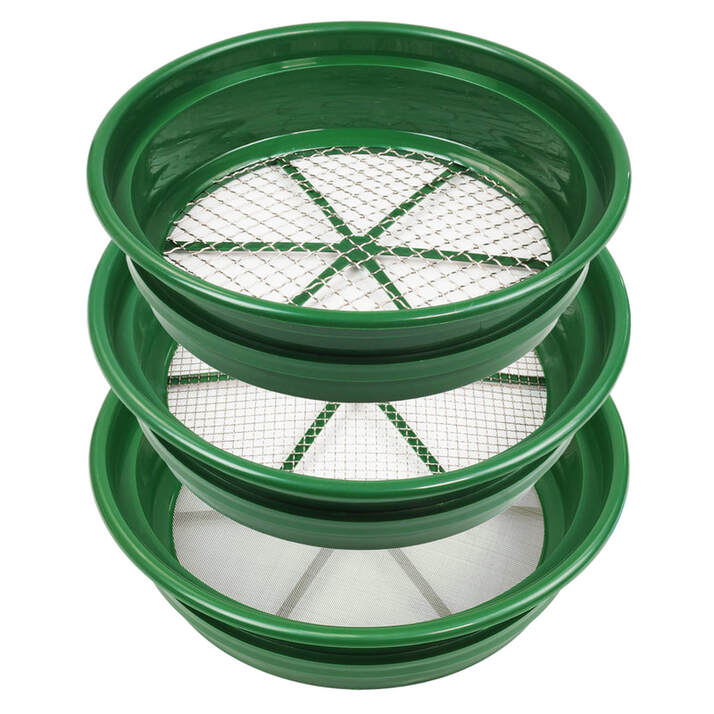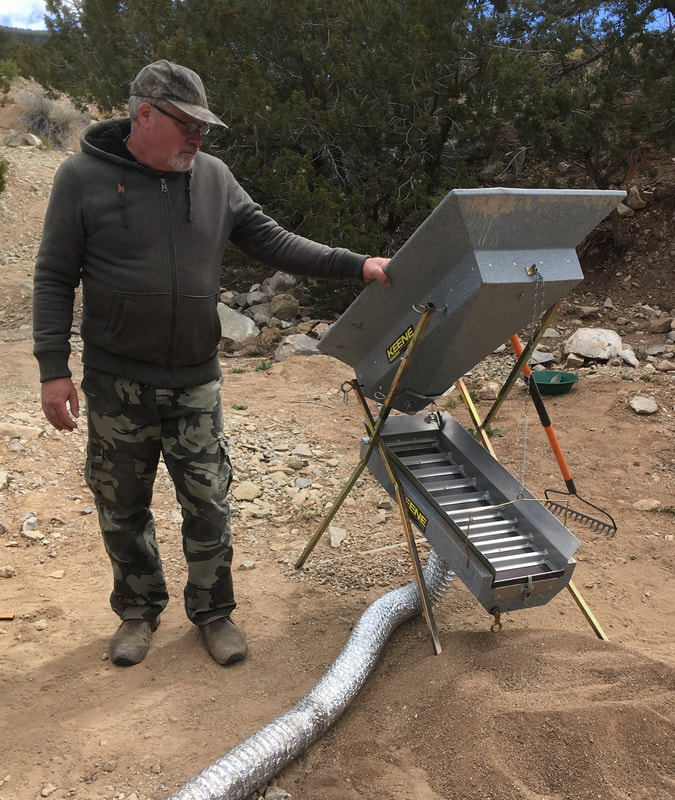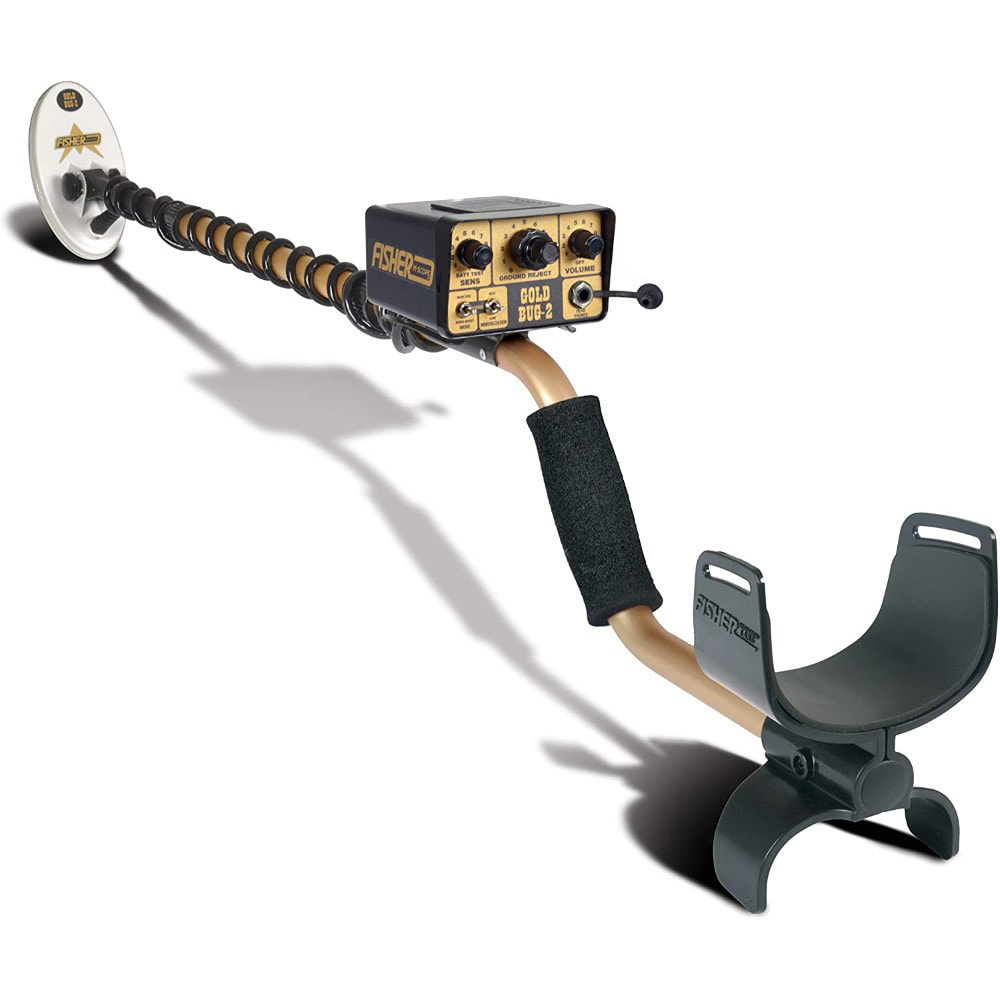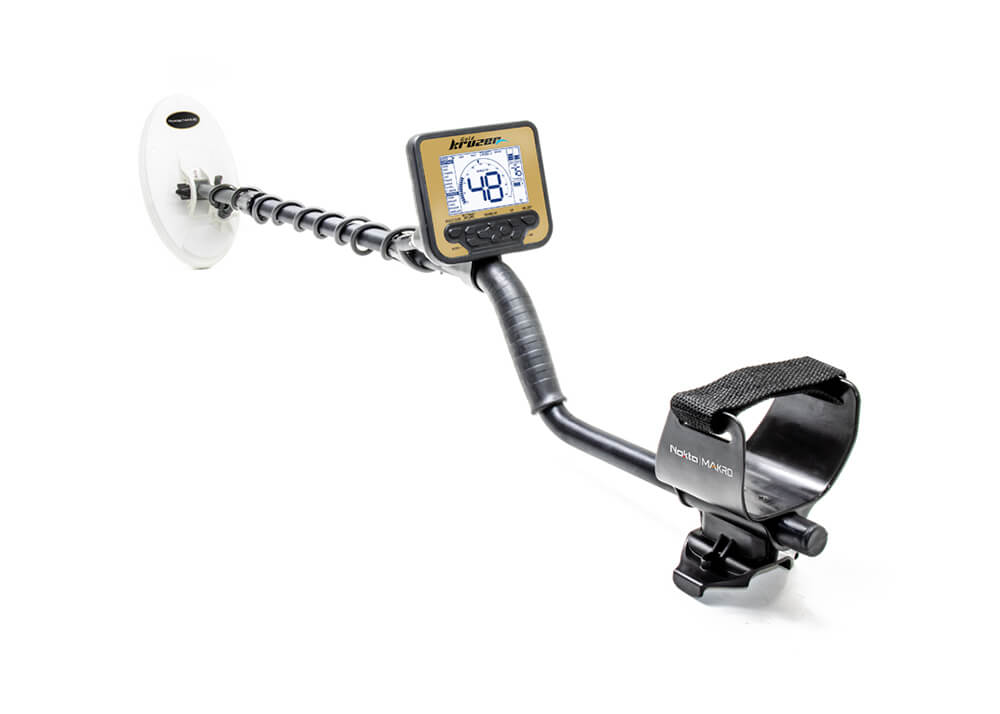There are many tools that are used to find gold and recover it. This page describes some of the gold prospecting equipment that you will need when you are gold prospecting in gold bearing country. What is presented here is only basic information. To get more information head to the Internet and search on "gold prospecting", or talk to knowledgeable prospectors in a local club or association. We encourage our members to learn and teach others the techniques of gold prospecting.
Shovels, Scoops and Buckets
Some of the most basic equipment that you will need is at least one shovel, at least one scoop, and buckets. The shovel should have a long straight-handle (to minimize bending over), be rugged but light-weight (makes big difference when you swing that shovel all day), and preferably have a rounded point (it digs better). Scoops are used to, well, to scoop smaller amounts of dirt. The best scoops to use for gold prospecting are plastic scoops. Even a plastic garden trowel works well. A plastic scoop and a metal detector always go together. Buckets are very useful for many reason: they hold things, like small tools, gloves, knee pads, water and dirt. Seems like you never have enough buckets! Plastic buckets are lighter than metal buckets, but they won't last as long. Some classifiers (mentioned below), which filter dirt, fit nicely on the top of 5-gallon buckets. 5-gallon buckets can be bought at any big box story. Below are some photos of typical shovels, scoops and buckets.
Gold Pans
A gold pan is a very common gold prospecting tool. Most gold prospectors will have several gold prospecting pans. Unless you are metal detecting, a gold pan is the most common tool for separating gold from rocks and dirt, and gold panning is a highly-recommended skill that every gold prospector should learn and use.
Gold pans themselves come in many shapes, sizes and colors. Most pans today are made of plastic. Plastic pans have many advantages over metal, like being lighter-weight, non-magnetic, won't rust, are very rugged and come in many colors. Removing black sand in a metal pan is not possible with a magnet. (We'll talk about Black Sand Separators later. See below.) Blue pans show the gold better, black pans visually hide the black sand, with green pans being a nice compromise. Below are some of the pans you'll see on the market today. Historically, and still used in many countries around the world (but not so much in the USA), is the Batea pan. The most common pan that you will see is, or is a variation of, the popular Garrett Super Sluice pan.
Gold Pans
A gold pan is a very common gold prospecting tool. Most gold prospectors will have several gold prospecting pans. Unless you are metal detecting, a gold pan is the most common tool for separating gold from rocks and dirt, and gold panning is a highly-recommended skill that every gold prospector should learn and use.
Gold pans themselves come in many shapes, sizes and colors. Most pans today are made of plastic. Plastic pans have many advantages over metal, like being lighter-weight, non-magnetic, won't rust, are very rugged and come in many colors. Removing black sand in a metal pan is not possible with a magnet. (We'll talk about Black Sand Separators later. See below.) Blue pans show the gold better, black pans visually hide the black sand, with green pans being a nice compromise. Below are some of the pans you'll see on the market today. Historically, and still used in many countries around the world (but not so much in the USA), is the Batea pan. The most common pan that you will see is, or is a variation of, the popular Garrett Super Sluice pan.
When you get good at gold panning, you can take a pan full of promising dirt, straight from the ground, and do all the processing down to just gold. However, gold panning takes time, even for the pros, and since time in the field is important, experienced gold prospectors will often just pan enough dirt out of their pan to determine if they are, or still are, "on the gold". If they do see gold, or "see colors", they will most often dump what is in their pan into a collection bucket, and go dig up some more promising dirt that hopefully contains gold, and repeat the process. By panning, a gold prospector is increasing the concentration of gold in the dirt. They are creating "cons". By putting cons in a bucket, the goal is to process the cons down to just gold leisurely at home.
Another way to help get your cons is to use a classifier. See the Classifiers section below.
Another way to help get your cons is to use a classifier. See the Classifiers section below.
What's the best pan?
As you saw above there are numerous pans on the market. Below are YouTube videos showing a few pros evaluating some of the pans. Click on the bold underlined text to see the video.
Dan Hurd evaluates the Pyramid Pan Pro, Gold Hog Flow Pan, Gold Claw production Pan, Garrett Super Sluice, a Flat Pan, and a Batea Pan.
Gary Honan starts out discussing what makes a good pan. He follows up with an excellent video on how to pan.
Chris Bogusis demonstrates the Batea pan.
As you saw above there are numerous pans on the market. Below are YouTube videos showing a few pros evaluating some of the pans. Click on the bold underlined text to see the video.
Dan Hurd evaluates the Pyramid Pan Pro, Gold Hog Flow Pan, Gold Claw production Pan, Garrett Super Sluice, a Flat Pan, and a Batea Pan.
Gary Honan starts out discussing what makes a good pan. He follows up with an excellent video on how to pan.
Chris Bogusis demonstrates the Batea pan.
Water is your friend!
Notice in some of the gold pan images above, the gold pan is being used with water. Even though you can pan dry rocks, dirt and gold, or dry pan as it is called, gold panning using water is much preferred, because using water makes it easier, with a much better recovery rate, at getting to the gold. Water will also break up clumps of mud that may contain gold much quicker.
As we all know, we do not have much water in New Mexico, and that is especially true in most locations where gold is found. While it is very inconvenient plan on bringing a few gallons of water with you so you can at least pan using water.
Gold prospecting is work! In New Mexico you will be working at medium to high altitude, in low humidity, so YOU will need to drink water more often! Stay hydrated!
Snuffer Bottles
This simple but extremely effective device is used while panning for gold with water. A snuffer bottle is used to extract the gold out of a pan. The old-timers didn't have this plastic device. They ended up using a wet finger tip, tweezers, or a small brush to pick the gold out of their pan. The snuffer bottle below, in an optional homemade lanyard, all in a small gold pan, are ready for action.
Classifiers
An important part of extracting gold from rocks and dirt is the process called classifying. While classifying can be done using a gold pan alone it is much easier to use a device called a classifier to separate the rocks and dirt from the gold. Paraphrasing an old saying in gold prospecting, "If gold is the same size as everything else in your pan: gold wins!" What this means is, if you make all the material in your pan about the same size, getting to the gold will be much easier.
Each step in classifying increases the concentration of gold in your dirt, resulting in better cons. Classifying can be done many ways. The image below shows a set of three classifiers, each of which can fit over a standard 5-gallon bucket that you can purchase at one of the big box stores. These simple devices are uniquely defined by the spacing in the screen that you see in the bottom of each classifier. From the top to bottom, these are #2, #4 and #30 classifiers, in other words, the grid in the top classifier has a screen spacing of 1/2-inches, next one down has a screen spacing of 1/4-inches, and the bottom one has a screen spacing of 1/30-inches. You can buy classifiers with other screen spacings, but a #2 and #4 will serve you well when starting out.
Classifiers can be used with or without water. But as was mentioned before, using water yields better results.
Black Sand Separators
In New Mexico gold bearing dirt will often contain "black sand". Black sand is usually a combination of the minerals hematite and magnetite that have been eroded down into find particles that resemble sand that is black in color. The rocks and dirt in your pan are fairly easy to separate from the gold, but the black sand, because it is closer to the density of gold, is much more difficult to separate from the gold. Fortunately black sand is magnetic and gold is not, so you can use a magnet to remove the black sand from your pan. Removing the black sand will also increase the concentration of your cons, which is a good thing. [need to add a few images]
Trommels
A Trommel is a special type of classifier, but its job is the same -- increase the concentration of gold in your dirt, resulting in better cons. Trommels come in many sizes, configurations, used with water or without water, and are operated by many methods, but they all are made with a classifying screen that is bent into a cylinder, attached to a cylindrical structure, and the whole assembly is rotated.
Below are two YouTube videos showing homemade trommels. Gold processing trommels seems to be a device that attracts the DIY'ers.
Allan Guthmiller and Alan Robertson are two of many who like building and using trommels. They are included here because they are good at explaining how to build trommels and using them.
Allan Guthmiller and Alan Robertson are two of many who like building and using trommels. They are included here because they are good at explaining how to build trommels and using them.
Dry Washers
Dry washers are mechanical devices that have been used for many years. They can only be used in very dry environments, like we often have in New Mexico. Dry washers of old are very similar to the dry washers used today, the only difference being the use of modern materials and the drive mechanisms. Dry washers are used to increase the concentration of gold in your dirt. Sound familiar. However, dry washers are not as good at catching the gold as wet techniques, such as sluices. For a technical discussion on this topic check out the link here.
Even after running dirt through a dry washer, the concentrated dirt, or cons, still need to be processed further. See the section called Processing Cons.
Mike Ault with his Keene 151 Dry Washer. This dry washer will keep 3 young men busy!
Jeff Haynie has a great video on what a dry washer is and how to use it. You can watch his YouTube video here.
Sluices
If water is available a sluice is a great way to separate gold from dirt and rocks. The photo below shows a sluice being used in a small stream of water. Sluices come in many sizes, shapes and matting, but they all use water. Like classifiers, trommels, pans, and dry washers, sluices are used to increase the concentration of gold in your dirt. Even after running dirt through a sluice, the concentrated dirt, or cons, will still need to be processed further. See the next section called Processing Cons.
The matting used in a sluice attempts to recreate the natural environment when water flows over the bottom of a river or stream bed. The matting creates just enough turbulence to let rocks and dirt pass over and by, but mats will attempt to capture the gold because gold is heavy and hopefully it falls down into the matting. There are miner's moss mats, low-profile mats, high-profile mats, V-groove mats, micro and mini vortex mats, dream mats, combination mats, and the company Gold Hog alone has 11 proprietary mats (as of 2024), just to name a few! Matting is a huge topic, and will not be discussed further. Do your own research on "sluice mats"!
A sluice in operation.
Processing Cons
Processing cons can be done by many techniques. Again, it's a process of increasing the concentration of gold in your dirt, but this time the goal is to get down to just having gold. Common techniques to accomplish this are panning, sluices, Gold Cube, Blue Bowls, spirals, Miller tables, shaker tables, and gold tubes, to mention a few.
Panning is the most common technique for processing cons, so again, it is a skill that every gold prospector should learn and use. However, panning is slow, meaning, you can not process a lot of material quickly. That is why there are other gold-separating techniques that move, or process, material much quicker, but they cost money.
To learn about how to use all the tools mentioned above, or see them in action, check out the How to and Demonstrations section.
Chris Bogusis, in his video here, discusses many aspects of Processing Cons. Even though he lives in Australia where he has to deal with tin in his concentrates (which we normally don't have to worry about), the process, techniques, even the jargon, of processing and cleaning up gold, are the same no matter where you live and prospect.
Metal Detectors
A Metal Detector is the relatively new high-tech way to find gold. It certainly does not replace the "old" techniques, it is just a new tool to prospect for gold. It is important to note that gold is best found with a metal detector that is designed specifically to find gold. A treasure hunting metal detector will find a large gold object, like a coin, ring, bracelet or the rare big gold nugget, but it probably will not be able to detect the more numerous small nuggets of gold.
How do metal detectors work?
This topic can get very technical very quickly, but the webpage here has a good discussion on how a metal detector works.
It is important to note that gold is best found with a metal detector that is designed specifically to find gold. A treasure-hunting metal detector, which are generally less expensive, will find a large gold object, like a coin, ring, bracelet or the rare big gold nugget, but it will not be able to detect the small more numerous nuggets. A gold metal detector will find those smaller pieces of gold.
Below are a few of the many popular metal detectors. These devices are relatively expensive, but they are designed to detect small gold. So, do your research, talk to metal detector owners, before you buy.
Fisher Garrett Minelab Nokta Makro
Gold Bug 2 AT Gold Gold Monster 1000
Containers to show off your gold
When you do get some gold, you might want to show it off in a small bottle, or if you are real lucky and get a big nugget, in a nice display tin. Below are some photos of gold in containers.
Gold Prospectors Association of New Mexico
GPANM HOTLINE: 505-898-5508
Our mailing address:
GPANM
P.O. Box 25472
Albuquerque, NM 87125-0472
GPANM
P.O. Box 25472
Albuquerque, NM 87125-0472
Copyright © 2021
















